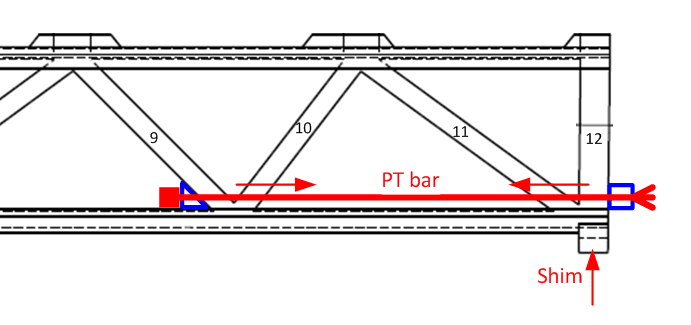I'd appreciate if someone savvy in structural engineering could clarify a few points in the recently-released"FIGG Structural Analysis Presentation Meeting Minutes" document. (
[URL unfurl="true"]https://cdn2.fdot.gov/fiu/14-FIGG-Structural-Analysis-Presentation-Meeting-Minutes.pdf[/url]).
1. The doc uses phrases like "capture the nodal zone" (referring to the 11-12 node). What sort of structure does "capture" imply adding?
2. My non-expert reading is that FIGG seemed more concerned with the vertical load causing problems (hence the shim recommendation) than constraining the horizontal load of #11. Is that a reasonable reading?
3. Page 27 gets to the topic of maintaining the connection of the 11-12 node to the deck, so as to be able to "capture the longitudinal force component of the strut"... ie: connect the strut's horizontal force to the deck's longitudinal PT bars. Page 28 shows some accounting of rebars crossing "assumed shear plane". Which plane would this be?
4. Page 29 assesses "nodal shear stability" in a way that might be problematic. If I understand correctly, this looks at transverse forces across the deck, east-west) compressing ("confining") the concrete in the region of the node. It assumes an even distribution of transverse tendons, spaced at 175/65 ft, or 2.7 feet, then applies the force implied to a 4.75-ft "side" of the region of interest. This 4.75 ft is presumably the length of the oblique connection of #11 to the deck.
However drawings such as this one:
[URL unfurl="true"]https://cdn2.fdot.gov/fiu/13-Denney-Pate-signed-and-sealed-FIU-bridge-construction-plans.pdf[/url] page 69 appear to show that there are no transverse tendons (or at most 1) in the end region of the deck or diaphragm, the first one coming at something like 3ft 8in from the end (on the plan view), or maybe 4ft 5in (View B-B), or maybe 4ft (page 71, view B-B) or maybe 4ft 2.5in (page 85).
So it seems to me that not only were there either zero or just one horizontal tendons in this area, but they were not distributed evenly over the area of interest, with the compression effect tapering off rapidly toward the endmost region of the deck where the longitudinal force (and its horizontal component) would be most focused. Certainly there will be some compression from the endmost transverse tendon, and diminishing amounts from the second, third etc, but the compression won't be in a strictly transverse direction.
Am I reading this right?
5. The FEA graphics on pages 36 through 43 I think treat the members as homogeneous objects, and led to the conclusion "the spalled areas have not been replicated by the engineering analysis" (page 44). As it turns out, I guess this is a reminder that if the analysis doesn't predict what is actually happening, then the analysis is wrong. Presumably one or more of the actual members were no longer functioning as homogeneous objects, but instead had internal cracks severe enough to require a more complex model for analysis.

